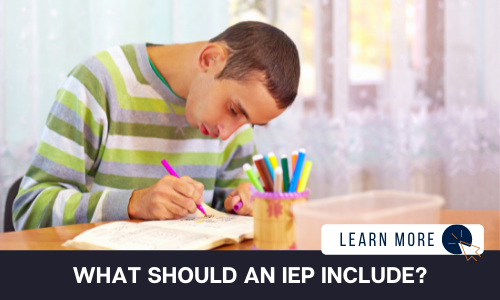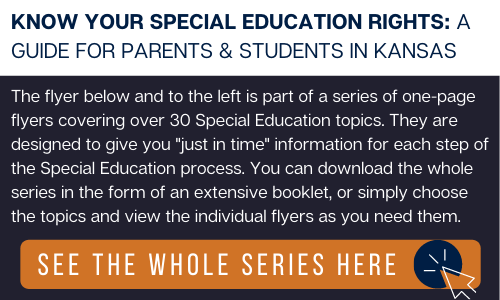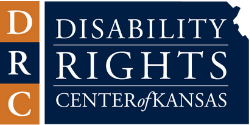What should an IEP include?
 |
 |
PDF Version: What should an IEP include?
Full Guide of all 30+ Flyers (Compiled as a Booklet)
Versión en Español en Formato PDF: ¿Qué Debe Incluir un IEP?
An IEP (Individualized Education Program) is a written document that includes how your child is doing, your child’s goals, and what your child needs.
The IEP must include how your child is doing in school. The school may call this a present level of achievement and functional performance (PLAFP) report. It explains how their disability affects them at school. It can also include skills that your child uses to be independent. These are called functional skills and they could include:
• Life skills: used to take care of themselves (feeding, dressing, using the toilet, walking, etc.)
• Functional academic skills: academic skills also used to be independent (counting, telling time, budgeting, reading, etc.)
• Social skills: skills used to interact with others (expressing feelings, needs, and wants, having conversations, etc.)
• Community-based social skills: skills used to live independently in a community (using public transportation, shopping, going to restaurants, walking safely outside, etc.)
The IEP must include your child’s goals for the next year. The IEP team looks at how your child is doing in school and sets the goals for the next school year based on what areas they need help with. The goals must be measurable and achievable within one year. It will explain how the school will measure your child’s progress and how the school will update you.
• A measurable goal means that the goal will state an action. It will say how much of that action your child will be able to do (ex: read 96 words per minute with 85% accuracy). It says when your child will be able to do it (ex: in 20 weeks, by the end of the school year). It will say under what conditions your child will do the action (ex: when given third grade reading materials).
- Measurable goals help you and your child’s school know whether your child is making progress or not.
• An achievable goal means the goal is something that your child will be able to do within a one-year period. However, the goal also must be ambitious. Don’t let the school set a goal that is easily achieved. The goal needs to be based on the strengths and needs of your child. You and the rest of the IEP Team must focus on goals that are meaningful.
The IEP must state how your child’s progress will be reported to you. The IEP must also state specific services and supports your child needs to progress in regular education. The IEP will list specific things the school must provide, such as services, aids, accommodations, assistive technology, modifications and supports.
It’s very important for you to speak up for your child. Look at the IEP closely. Does it reflect how your child learns best? Will the services and supports in the IEP help your child? Ask about other ways that your child’s needs can be met. Offer ideas. Remember, you know your child best.
Review the services that are listed on the IEP and must be provided to your child. Does each one list when, where and who is responsible for giving these to your child? If not, make certain the IEP includes that information.
The IEP must include when and where your child will learn. Every service must say when it will start, how long it will last, how often your child will receive the service, and where your child will receive it. Details are important. These details are required by the law.
The law requires that your child be taught in the least restrictive environment (LRE). This means your child should be in the same classrooms as other children as much as possible. They will participate in what schools may call the “general education curriculum.” The IEP must explain the times and situations that your child will not be with students who don’t have disabilities.
See more: What is the Least Restrictive Environment?
Extracurricular and/or nonacademic activities are also included in the IEP. These are not part of general education classes but are school sponsored. Examples include sports teams, band, field trips, after-school programs, etc. The IEP must include how your child will be a part of these activities.
The IEP will also show if your child qualifies for Extended School Year (ESY) services. ESY services are usually provided in the summer.
See more: What is Extended School Year?
If your child has behavioral needs, the IEP may also include a behavioral intervention plan.
See more: What is a Behavioral Intervention Plan?
If your child is 14 or older, the IEP must include how your child will transition out of high school. This is sometimes called a “transition plan”. The transition plan includes their goals for after high school and the services that they will need.
See more: Transitioning from high school as a student with a disability
These services could include the Kansas Vocational Rehabilitation (VR) program. VR is critical to helping your child get a job after high school. If your child is interested in VR services, a Kansas VR representative should come to the IEP meeting. VR can provide lots of services to help your child transition to adult life.
See more: How can VR help with my child's transition?
You and everyone else on the IEP team will sign that you attended the IEP team meetings and obtained a copy of your rights. You will also sign whether or not you agree with the IEP. If you disagree with the IEP, you should work with team to try to reach an agreement. It is best to keep meeting until you can agree. Do not sign that you agree with the IEP until you are comfortable with the final version. However, your refusal to sign may not stop the school from implementing the IEP. Talk to Families Together and the Disability Rights Center of Kansas for more information. There is not a time limit for how long the IEP Team meeting can last. Some meetings can last longer than others. It may take more than one meeting to make sure the IEP document is what your child needs.
Sources & Additional Resources:
What is an IEP? Disability Rights Center of Kansas & Families Together, Inc.
Kansas Special Education Process Handbook. Kansas State Department of Education.
Disclaimer: This fact sheet is not intended to provide specific legal advice. If you need legal advice, please contact an attorney. Only an attorney can give you specific legal advice based on your particular situation. We try to update our materials regularly, but the law can change frequently. This publication is based on the law at the time that it was written. Future changes in the law could make information in this fact sheet inaccurate.
.png)





